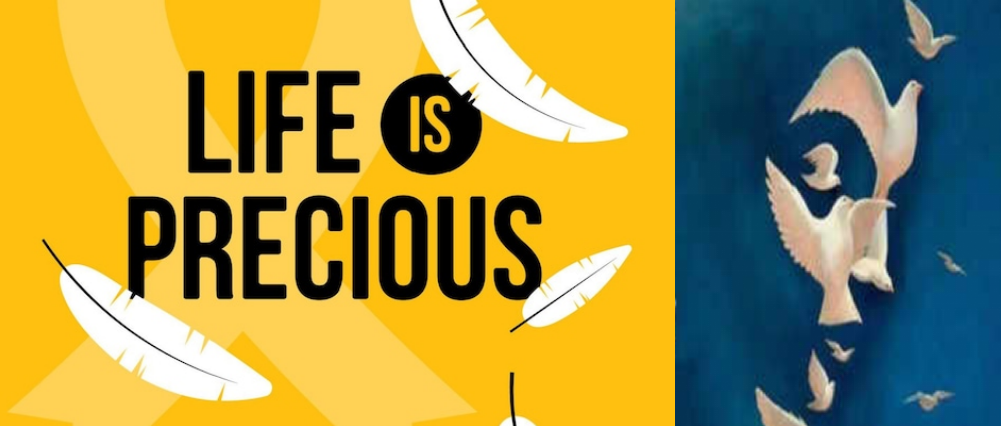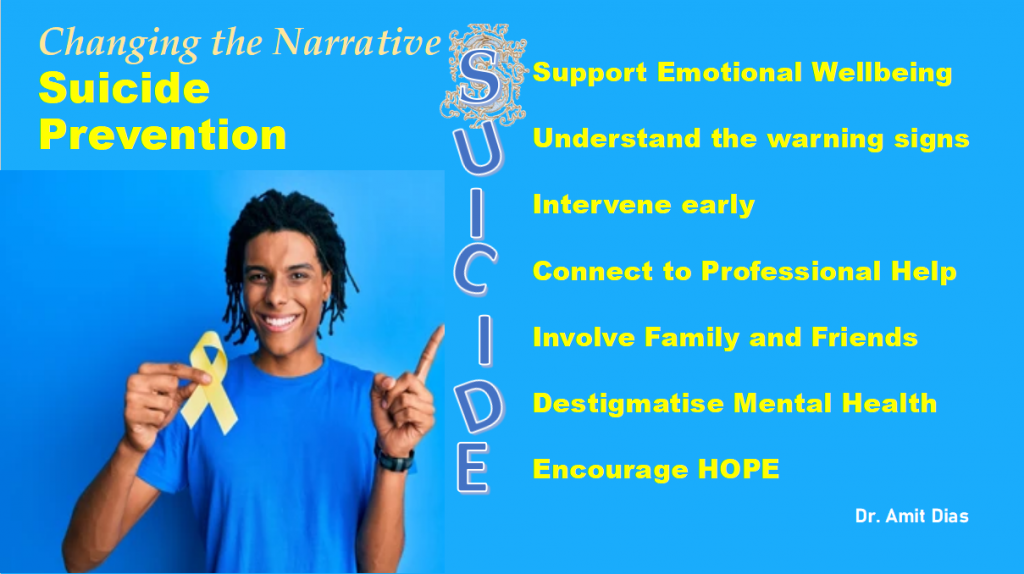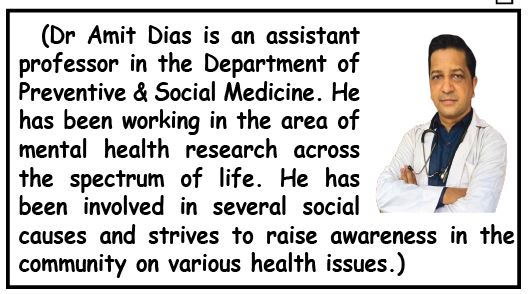Goa is abuzz with excitement as vintage bike and car owners, users, collectors and fans are decking […]

CHANGING THE NARRATIVE ON SUICIDE!
MIND & BODY, HEART & SOUL, Sep 14- Sep 20 2024 September 13, 2024World Suicide Prevention Day Special!
As the world observed World Suicide Prevention Day on September 10 we spoke with Dr Amit Dias to understand the complexities of suicide and the ways to prevent it. He says, “We need to change the narrative on suicide and start talking about it. We can all join hands to prevent suicide.” Life is precious.
A Q&A interview with Dr Amit Dias
Goan Observer: Doctor, we hear about suicides so very often. What is the global burden of suicide?
Dr Amit Dias: Yes, suicide is a major public health problem, with more than 7 Lakh deaths annually around the world. We often feel that nothing can be done about it and refuse to talk about it most of the time because it is taboo. However, it’s time to change, and change the narrative around suicide.
Most of us would know someone would have ended their life prematurely due to suicide. We often know this unfortunate incident could have been prevented with timely intervention. Suicide does not end the pain, it just passes it on to the others. Each suicide has far-reaching social, emotional and financial consequences, and it profoundly impacts individuals as well as the community.
What is even more worrisome is that suicide is affecting the young. Children find it difficult to cope with the stress of competition and think that life is not worth living. Suicide is the fourth leading cause of death in youth aged 15-29 years. In our country alone, we have around 12 deaths due to suicide per lakh population every year.
On Suicide Prevention Day everyone should be aware that depression can be treated, suicide can be prevented, and we all have to change the narrative around suicide as the theme suggests.
Q: What is the theme for World Suicide Prevention Day this year?
A: The theme not only for this year but for the next three years is “Changing the Narrative on Suicide.” Through this campaign, the WHO hopes to start a conversation to fight the barriers of stigma and social restraint and address the elephant in the room through conversation, empathy and support.
We need to be the change we want to see. By starting these conversations, we can change the narrative, raise awareness, bust the myths, break down barriers and create a better environment for support. World Suicide Prevention Day (WSPD) was established in 2003 by the International Association for Suicide Prevention in conjunction with the World Health Organization (WHO).
Q: How do we prevent suicides?
A: Prevention can be done by following simple steps. For simplicity let me use the word SUICIDE to explain.
S – Support emotional well-being: Encourage open conversations and offer emotional support to those struggling.
U – Understand warning signs: Learn to recognize symptoms of depression, anxiety, withdrawal, or hopelessness.
I – Intervene early: Take action when you see warning signs, don’t hesitate to reach out or offer help.
C – Connect to professional help: Guide individuals to mental health professionals, helplines, or support groups.
I – Involve family and friends: Foster a supportive community by involving trusted loved ones.
D – De-stigmatize mental health: Promote awareness and eliminate the stigma around seeking help for mental health issues.
E – Encourage hope: Offer positive reinforcement, help individuals set small goals, and remind them that they are not alone.
Q: You mentioned “understand the warning signs,” what exactly are the red flags for suicide?
A: Prevention starts with first being familiar with the signs and red flags for suicidal behavior. This is a cry for help and we need to reach out to them and provide the first aid.
Here are some of the warning signs of those at risk:
A patient undergoing unbearable emotional or physical pain
A person who feels they are a burden to others.
A person who talks about wanting to die or kill themselves.
Those who say they feel hopeless, empty, and feel it’s pointless to live.
Those who say they feel trapped or feel that there are no solutions to their problems.
Those in a narcissistic relationship — at work or home.
Those who withdraw from family and friends.
Those who suddenly give away important possessions, put affairs in order.
Those who say goodbye to friends and family for no obvious reason.
Those who take risks that could lead to death, such as driving extremely fast.
Those who often talk about death.
Those found to be searching for lethal methods online, collecting and stocking pills, buying a gun.
Talking about feeling great guilt or shame
Using alcohol or drugs more often.
Acting anxious or agitated.
Changing eating or sleeping habits.
Those with a history of suicide attempts or a family history of suicide.
Those exposed to family violence, including physical or sexual abuse.
Those exposed to others’ suicidal behavior, such as that of family members, peers or celebrities
Q. Does that mean that people who have these thoughts and behaviors will attempt to end their life?
A: No, remember, most people who have risk factors for suicide will not attempt suicide….however, it is important to recognize these risk factors as these people may be at higher risk and need immediate attention. Men are more likely to commit suicide and people in the LGBTQ community are found to be more vulnerable.
There are several other factors — poverty, conflict, disaster, war, broken relationships, legal and financial problems, bullying, ragging, failure in exams, etc, that can make the person vulnerable to suicide.

Q: You also mentioned first aid in this complex situation… how can one go about it if they know of someone with suicidal ideation?
A: If someone tells you that they are going to kill themselves, do not take it lightly. Tell a trusted friend, family member, or other trusted adult. We may sometimes see such messages on social media. Do not underestimate the power of talking to someone. You can bring out a person from the most hopeless situations. One needs to take cognizance and reach out to them. Help them seek help and speak to a counselor, psychiatrist, or a family doctor. If the person is depressed, medication is available. There are alternatives to suicide and through our action, we can encourage the person to take a new path and save their life.
Q: You mentioned that adolescents are at greater risk of suicide. Is there any advice you would like to give them?
A: The rise in suicides among adolescents is a complex issue, often driven by academic pressure, social comparison, the influence of mobile phones and online challenges. By adopting evidence-based interventions, fostering a supportive environment and addressing the role of technology, we can significantly reduce the risk of suicide in this vulnerable population. Early intervention, mental health support, and reducing the pressure to be perfect are key elements of prevention
Reduce the Pressure to be Perfect
THE pressure to excel academically, exacerbated by societal, parental, and self-expectations, can lead to significant stress in adolescents. The concept of “perfectionism” has been scientifically linked to mental health issues, including depression, anxiety, and suicidal ideation. Studies show that adolescents who feel constant pressure to achieve high grades or meet unrealistic expectations are more vulnerable to emotional breakdowns, especially during exam periods or intense coaching sessions.
Address the Impact of mobile phones and the Internet
THE constant exposure to social media and online platforms can amplify feelings of inadequacy and fuel a need for perfectionism. Adolescents often compare themselves to others on social media, leading to anxiety and feelings of low self-worth. The use of mobile phones and the internet has also been associated with increased screen time, affecting sleep and mental well-being.
Mental Health Support
EVIDENCE shows that early identification and intervention can significantly reduce the risk of suicide. Schools, coaching centers, and parents must be trained to recognize warning signs of suicidal behavior, such as social withdrawal, expressions of hopelessness, and changes in behavior.
Addressing the Impact of online games
IN recent years, there have been alarming cases of youth committing suicide after playing online games that promote harmful behavior. Games like “Blue Whale” and similar online challenges have been linked to psychological manipulation and self-harm in vulnerable adolescents.
Approach:
• Promote a growth mindset: Encourage children to focus on effort and learning rather than solely on outcomes. Research shows that fostering a growth mindset can reduce stress and improve resilience.
• Parental education: Educating parents on the importance of emotional support over perfectionism can help reduce the burden children feel. Parents must emphasize well-being over academic success.
• Academic counseling: Schools and coaching centers should offer psychological counseling services to help students manage stress and set realistic goals.
• Handle online influence: Limit screen time together with digital literacy to ensure the prevention of cyberbullying and negative online influence is to be ensured.
Q: That is a lot of useful information that needs to be implemented. What is your final message to our readers?
A: We need to change the narrative on suicide, we need to prioritize suicide prevention and mental health in policymaking and work with the government to initiate proactive steps for action. Changing the narrative requires advocating policies that prioritize mental health, increase access to care, and provide support for those in need. There is a lot of stigma and myths that surround suicide and we need to overcome it and be ready to talk and take action to instil hope in the minds of people to help them understand that their lives are precious.















